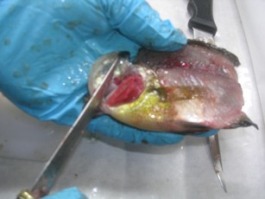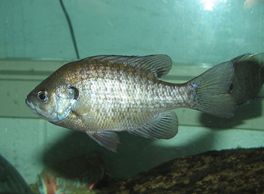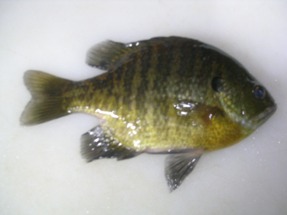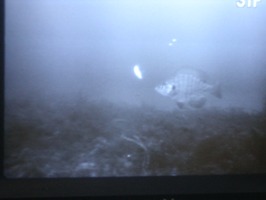Navigation
Changing Form and Function for a Changing Environment
General Fish Adaptations
 Bluegills contain
numerous adaptations that allow them to live in aquatic niches.
Some structures found in most all fish species include jaws, an
endoskeleton, and gills. As time has passed, bluegills
have evolved specific structures that allow them to gain
nutrients, avoid predators, and reproduce successfully.
Bluegills contain
numerous adaptations that allow them to live in aquatic niches.
Some structures found in most all fish species include jaws, an
endoskeleton, and gills. As time has passed, bluegills
have evolved specific structures that allow them to gain
nutrients, avoid predators, and reproduce successfully.
| Gills of a Mature Bluegill (Image taken by Author) |
Bluegill Adaptations: Movement
Bluegills have
the ability to travel and turn at different angles and speeds
because of synchronized fin movements. To move forward, they
 use caudal fins, soft dorsal fins, body undulations, and pectoral
fins. The speed of forward motion depends directly on the
abducting and adducting fins. A slender body negates
resistance as bluegills can essentially slice through water.
To turn, this species relies heavily upon the angular orientation of
their pectoral fins. These large, flexible fins can also allow
bluegills to brake quickly. In many ways, the degrees of
maneuverability facilitates them to forage and escape predators with
great efficiency. Other incredible sensory adaptations have
allowed bluegills to succeed throughout aquatic ecosystems in North
America.
use caudal fins, soft dorsal fins, body undulations, and pectoral
fins. The speed of forward motion depends directly on the
abducting and adducting fins. A slender body negates
resistance as bluegills can essentially slice through water.
To turn, this species relies heavily upon the angular orientation of
their pectoral fins. These large, flexible fins can also allow
bluegills to brake quickly. In many ways, the degrees of
maneuverability facilitates them to forage and escape predators with
great efficiency. Other incredible sensory adaptations have
allowed bluegills to succeed throughout aquatic ecosystems in North
America.
Bluegill Adaptations: The Sensory System
Unfortunately for bluegills, water is not a favorable median for
sensory reception. Some fish, including bluegills, contain a
lateral line that detects vibrations and other pressure changes.
Bluegills have hair cells within their lateral line and inner ears
that act as receptors for these vibrations and variations in
pressure. For instance, if a predator approaches, a bluegill
can likely sense the water displaced by the fins of the predator.
In comparison, possible food sources can also be detected. It
is true, however, that bluegills depend heavily on
 sight to gain
their nutritional needs. The structure of their eyes is
comparable to other chordates like humans. They detect objects
through stimulation within their eyes and perceive the object to be
a predator, prey, or any other object with their nervous system. Optimal
sight occurs during daylight hours as the light allows more
contrast between an object and its background. Other
physiological adaptations allow them to forage resourcefully.
sight to gain
their nutritional needs. The structure of their eyes is
comparable to other chordates like humans. They detect objects
through stimulation within their eyes and perceive the object to be
a predator, prey, or any other object with their nervous system. Optimal
sight occurs during daylight hours as the light allows more
contrast between an object and its background. Other
physiological adaptations allow them to forage resourcefully.
| Structure of a Bluegill (Image taken by Author) |
Bluegill Adaptations: Foraging
The mouth of a
bluegill is very small (8.0 mm in diameter) (Spotte, 2007).
Still, the mouth's size fits its purpose. Instead of feeding
on
 gastropods like fish species with larger mouths, bluegills tend
to consume smaller species. When near a
possible food item, bluegills expand their pharynx to suck the item
into their tiny mouths. These adaptations permit bluegills to
be so successful in capturing prey, avoiding predators, and
competing with other species to gain resources.
gastropods like fish species with larger mouths, bluegills tend
to consume smaller species. When near a
possible food item, bluegills expand their pharynx to suck the item
into their tiny mouths. These adaptations permit bluegills to
be so successful in capturing prey, avoiding predators, and
competing with other species to gain resources.
| Foraging Bluegill (Image Taken by Author) |
